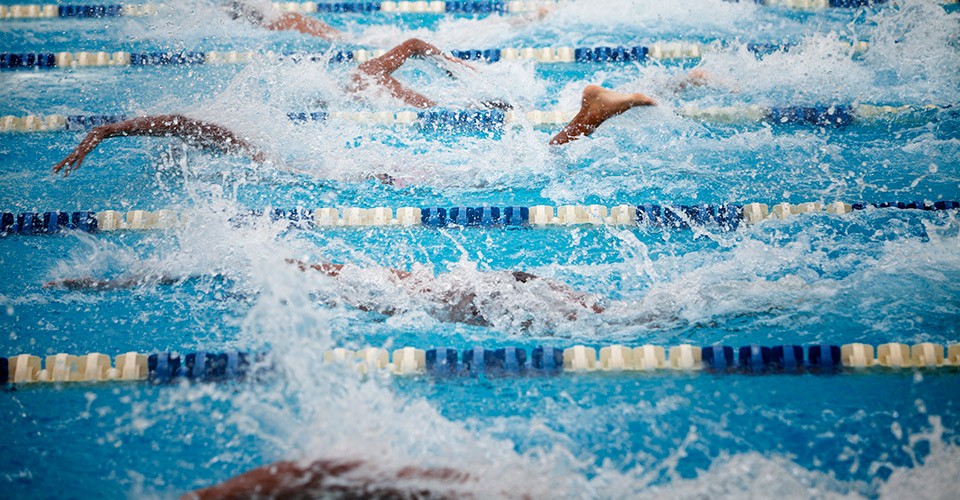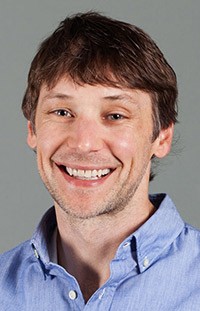Current Concerns
Lap-time data suggests the possibility of lane bias and unfair advantage at world-class swim events, according to EMU and IU researchers

Lane bias.
No, that’s not a traffic term, but rather a label for swimming against the current – favorable or unfavorable conditions in elite swimming competitions, depending on which direction you are heading in the pool.
Andrew Cornett has deeply immersed himself in the topic. His conclusions, along with those of several colleagues, carry significant weight for some of the world’s top competitive swimmers, for whom fractions of seconds can make a major difference in their competitive and financial success.

Cornett, a professor of exercise science at Eastern Michigan University, along with Indiana University researchers Joel Stager and Chris Brammer, conclude that lane bias can and does exist in elite-level swimming competitions, including the 2016 Summer Olympics in Rio De Janeiro and the 2013 World Swimming Championships in Barcelona.
They base that conclusion on extensive studies of swimmers’ times in each of the lanes in the events’ pools, determining that the 50-meter splits in distance freestyle events were consistently slower when swimmers were churning towards the finishing end of the pool as compared to away from it on one side of the pool (lanes 1-4), with the opposite being true on the other side of the pool (lanes 5-8), where swimmers were faster heading towards the finishing end than away from it.
That conclusion most affects the one-lap, 50-meter sprint races, as conditions would tend to cancel each other out as swimmers raced back and forth in the pool during longer events.
While the group did not measure the physical properties of the pools in each case, they conclude their results are consistent with the water currents in the competition pools, which must meet exacting standards.
“We hope that FINA, the entity responsible for ensuring fairness and equal opportunity for success (in the sport of swimming), will carefully consider this evidence and move towards rules and regulations that might keep similar lane biases from occurring at future competitions,” they wrote in a paper published last August, shortly following the Olympics.
“Most importantly, some procedure is needed to confirm that all sanctioned meets are free from external influences that unfairly hinder or assist race outcomes.”
It’s understandable how Cornett comes by such expertise. He studied under professor Stager while doing his masters and doctoral work at the Indiana University, which for years was the NCAA’s elite swimming program under legendary coach James “Doc” Counsilman.
It was Counsilman, who coached such Olympians as nine-time gold medalist Mark Spitz, who really began applying science to swimming. He started the Counsilman Center for the Science of Swimming, for which Stager now serves as director. Brammer also remains at Indiana, as a graduate instructor and researcher at the Counsilman center.
At Eastern, Cornett teaches classes in statistics, human physiology, human anatomy and exercise physiology. He earned his bachelor’s degree in kinesiology at DePauw University in Greencastle, Ind. At Indiana, he earned master’s degrees in exercise physiology and applied statistics, and then his Ph.D., in human performance.
“That’s where the nature of this (lane bias) project makes sense,” Cornett says of his extensive IU training. “There’s the swimming, there’s the statistics and there’s the performance issues all coming together …”
Now, having made the swimming world aware of the problem, along with having received extensive coverage, including an article in the Washington Post, the trio of Cornett, Stager and Brammer hope to see some action.
“Our goal all along has been to bring about awareness of lane biases in swimming in the hope that the problem would be addressed and then eliminated …” they wrote last August. “While high-ranking members of the swimming world seem to be taking note, our data suggest the problem persists.”
February 28, 2017
Written by:
Geoff Larcom
Media Contact:
Geoff Larcom
glarcom@emich.edu
734-487-4400
More Stories

Eastern Michigan University showcases “Sunstruck” in planetarium event.

Eastern Michigan University Registration Blitz increases university retention rates.

EMU Theatre presents "The Rocky Horror Show"

Eastern Michigan University to host Black History Month panel discussion on the future of Black politics in America – Feb. 3.

Eastern Michigan University's online cybersecurity master's program ranked among Cybersecurity Guide’s list of top affordable programs for 2025.

